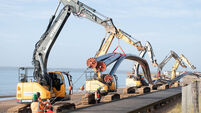Irish ports will need to spend €20m each to provide green power for cruise liners

Currently Belfast, with 180 visits per year, and Cork, with around 100, top the list of cruise liner destinations on the whole island. File picture: David Creedon
Irish ports must invest up to €20m each to provide electricity power points for visiting cruise liner ships by 2030 or be restricted to no more than 25 visits a year.
That’s under new EU regulations designed to reduce carbon emissions from the new breed of massive energy-guzzling liners being built in shipyards.
Currently Belfast, with 180 visits per year, and Cork, with around 100, top the list of cruise liner destinations on the whole island. These figures are forecast to grow further in the coming years.
Under the new regulations, ports will have to provide a hook-up to cruise liners to supply them with 15 megawatts of electricity, which is the equivalent of powering a town of up to 30,000 people.
Massive new cruise liners being built will need this kind of green power in port to keep their multiple systems running.
CLIMATE & SUSTAINABILITY HUB
Royal Caribbean is building two new mega-ships, the first of which 'Icon of the Seas' will enter service next year. The 250,800-tonne vessels will have 20 decks packed with all kinds of energy-sapping needs and cope with up to 7,600 passengers and 2,350 crew.
Captain Michael McCarthy, chairman of Cruise Europe, who represents 135 ports, maintains the cruise liner industry is actually ahead of the curve when it comes to dealing with environmental issues as there's already a huge amount of energy-saving and recycling going on within these massive ships.
"Shipping worldwide accounts for 3% of greenhouse gas emissions, with bulk carriers, tankers, and container ships the main contributors. In comparison, energy uses for road, rail, and air transport is around 73%,” Mr McCarthy said.
Meanwhile, he says Ireland can only benefit from a surge in cruise passengers trying to escape the sweltering heat enveloping traditional port destinations in Europe.
Capt. McCarthy says he's spoken to older passengers who are not getting off air-conditioned liners because they’re worried they’ll get sunstroke from the 40C-plus heat engulfing many harbours in the Mediterranean Sea.
He said many cruise liner passengers have told him in the future they'll seek more temperate areas where they can get off the ship and visit local attractions.
Capt. McCarthy said operators of traditional hotspot cruise liner port destinations around The Med now fear there will be a shift away from these locations to places where passengers will feel more comfortable disembarking for excursions.
Ports in Greece and Italy are particularly concerned about a significant loss of tourism revenue as temperatures continue to rise.
“If you come from Texas where it can be 50 degrees and you haven’t seen rain for weeks or months at a time then Ireland's a great prospect. They're not going to be coming here walking around in a bikini. They’re coming here to see Ireland’s culture, its history, its people, and temperate climate,” Capt. McCarthy said.
Apart from the obvious surge in Mediterranean temperatures, he said that there is already a ‘sea change’ developing in the industry for year-round cruise liner trips.
“We are seeing cruises coming out of the likes of Hamburg, Southampton and other ports which are going to Norway, Iceland, Greenland, etc. during the winter months where it's seriously cold. There is a huge opportunity for us to capitalise on this, such as selling our Wild Atlantic Way,” Capt. McCarthy said.












